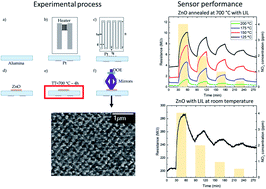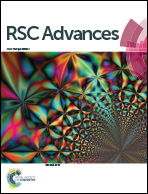Low temperature NO2 gas sensing with ZnO nanostructured by laser interference lithography
Abstract
ZnO conductometric gas sensors have been widely studied due to their good sensitivity, cost-efficiency, long stability and simple fabrication. This work is focused on NO2 sensing, which is a toxic and irritating gas. The developed sensor consists of interdigitated electrodes covered by a ZnO sensing layer. ZnO has been grown by means of the aerosol assisted chemical vapor deposition technique and then nanostructured by laser interference lithography with a UV laser. The SEM and XRD results show vertically oriented growth of ZnO grains and a 2D periodic nanopatterning of the material with a period of 800 nm. Nanostructuring lowers the base resistance of the developed sensors and modifies the sensor response to NO2. Maximum sensitivity is obtained at 175 °C achieving a change of 600% in sensor resistance for 4 ppm NO2 versus a 400% change for the non-nanostructured material. However, the most relevant results have been obtained at temperatures below 125 °C. While the non-nanostructured material does not respond to NO2 at such low temperatures, nanostructured ZnO allows NO2 sensing even at room temperature. The room temperature sensing capability possibly derives from the increase of both the surface defects and the surface-to-volume ratio. The long stability and the gas sensing under humid conditions have also been tested, showing improvements of sensitivity for the nanostructured sensors.



 Please wait while we load your content...
Please wait while we load your content...